How Taiwan’s tallest building survived the earthquake: Taipei 101 has a 660-ton pendulum that transfers energy to giant shock absorbers, allowing the 1,670-meter skyscraper to sway instead of topple
Taiwan has been hit by its strongest earthquake in 25 years, killing at least nine people, toppling buildings and even triggering tsunami warnings.
But amid the chaos, eerie footage shows the island’s tallest building – the $1.8 billion Taipei 101 skyscraper – gently swaying like a stick in the wind.
The building is 400 meters high and is equipped with an ingenious solution that reduces the total movement of the building during earthquakes and wind by 40 percent.
A 660-ton golden sphere, called the ‘tuned mass damper’, hangs from the 92nd floor of the building.
As the building moves in one direction, the steel sphere swings in the other direction, maintaining the overall balance of the building.
The key to Taipei 101’s impressive structural integrity is a 660-ton golden sphere hanging from the 92nd floor
If wind or the force of an earthquake pushes the tower to the right, the sphere will exert an immediate and equal force to the left, canceling out the initial motion.
So even though the tower sways, it doesn’t fall over.
It is a so-called ‘passive damping system’, meaning it works without any external force or control – just gravity and the movement of the building.
Meanwhile, hydraulic pistons beneath the solid sphere absorb the energy and dissipate it in the form of heat.
Dr. Agathoklis Giaralis, professor of structural dynamics at City, University of London, described the smart spherical device as “like a pendulum.”
‘This steel sphere rests on damping devices designed to damp the relative swaying motion between the structure and the sphere, in a similar way to the shock absorbers in car suspensions,’ he told MailOnline.
While it’s strange to see a building sway, modern skyscrapers are built to be flexible, especially in earthquake-prone areas like Taiwan.
‘The materials they are made of are elastic, meaning they stretch or contract depending on the changing loads acting on them,’ Professor Antony Darby from the University of Bath’s Department of Architecture and Civil Engineering told MailOnline.
‘The amount of this deformation in an individual element (for example a beam or column) is very small, but if you multiply this across all elements in a tall building it can lead to significant lateral (sideways) movements.
“These movements are not dangerous to the structure itself, but if excessive, may cause discomfort to the occupants.”
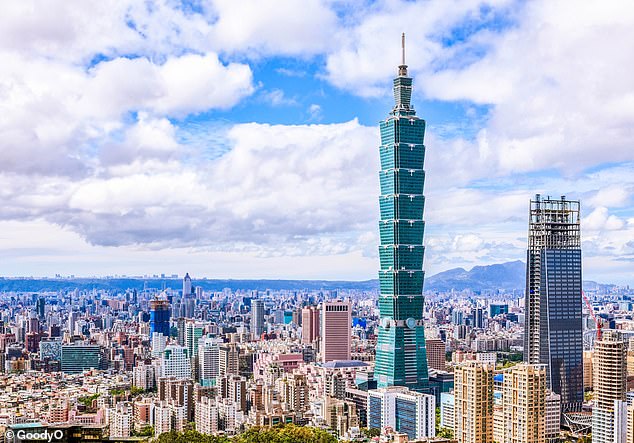
Taipei 101 is the tallest building in Taiwan and previously the tallest building in the world (now the 11th tallest)
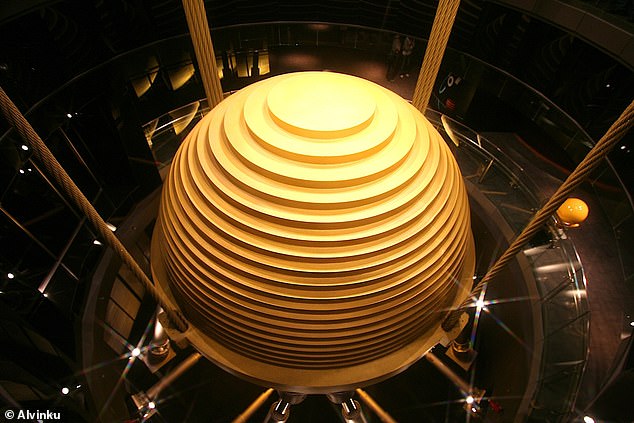
The key to the building’s astonishing structural integrity is a 660-ton golden sphere hanging from the 92nd floor – the ‘tuned mass damper’
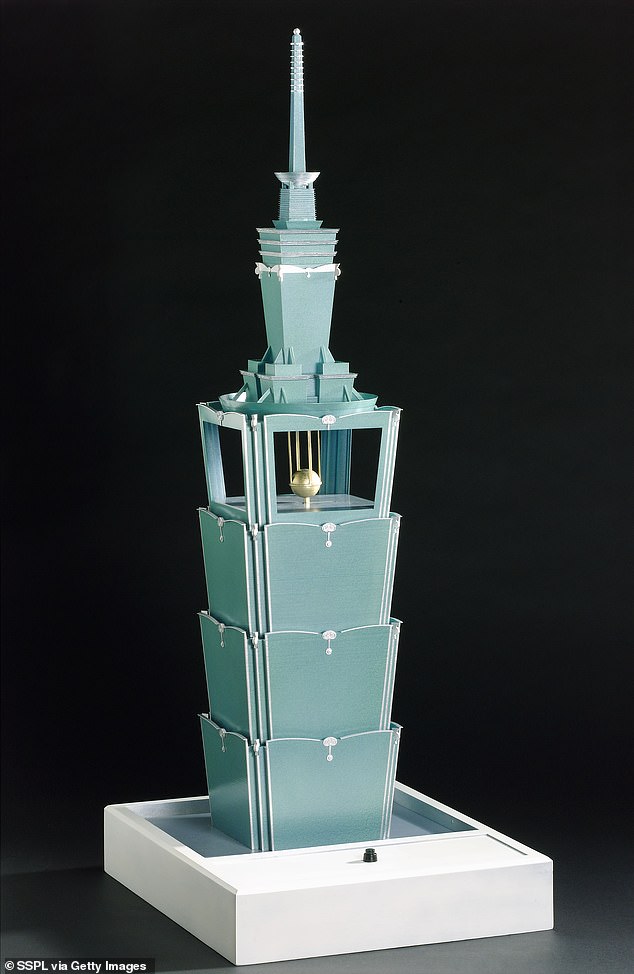
In Taiwan, Taipei 101 must be able to withstand earthquakes and typhoons. Every eight floors the building was fitted with supporting steel ‘outrigger trusses’ running from the building’s core to the outer columns to increase the tower’s rigidity. To prevent swaying and shaking during an earthquake, a huge tuned mass damper was installed – a device to transfer energy from the tower’s motion to giant shock absorbers. This 660-ton ball of stacked steel plates hangs from steel cables from the 92nd floor of the tower. It is connected to the building frame via eight fluid-filled shock absorbers
Construction of Taipei 101 began in 1999 and was completed in time for New Year’s Eve 2004, when it finally opened to the public.
It is designed to resemble a bamboo shoot rising upward in eight sections – resembling a series of square buckets stacked on top of each other.
Each floor was installed with supporting steel ‘outrigger trusses’ running from the building’s core to the outer columns to increase the tower’s rigidity.
While other tall buildings hide tuned mass dampers, Taipei 101 is visible to visitors on the 88th through 92nd floors, making it something of a tourist attraction.
Unfazed tourists have even filmed the movement of the sphere during previous earthquakes, which occur regularly on the island.
Taiwan is a country particularly prone to earthquakes because it is close to the convergence of two tectonic plates: the Philippine Sea Plate and the Eurasian Plate.
Strong seismic activity can be detected along the boundaries of the tectonic plates, where the plates rub against each other and cause earthquakes.
However, Taiwan’s earthquake preparedness is “among the most advanced in the world,” said Stephen Gao, a seismologist and professor at Missouri University of Science and Technology.
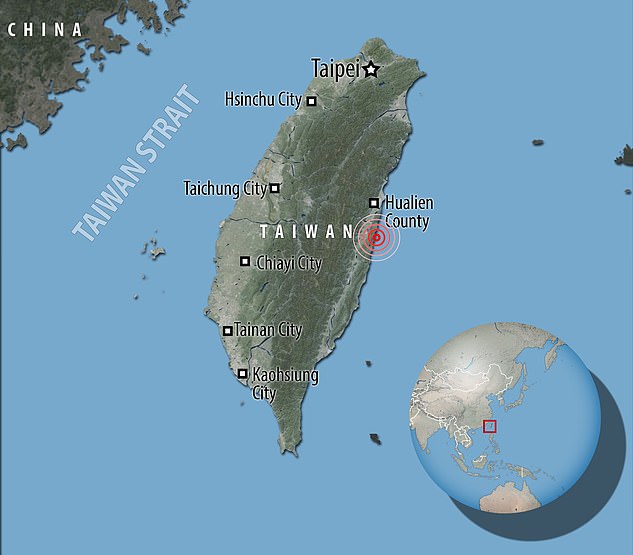
The powerful earthquake struck Taiwan’s east coast on Wednesday morning. Taiwan is a country particularly prone to earthquakes because it is close to the meeting point of two tectonic plates
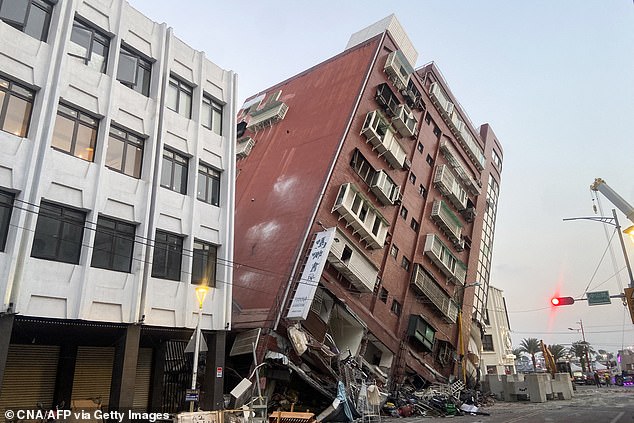
This photo taken by Taiwan’s Central News Agency (CNA) on April 3, 2024 shows a damaged building in Hualien after a major earthquake struck eastern Taiwan
“The island has introduced strict building codes, a world-class seismological network and widespread education campaigns on earthquake safety,” he said.
At the time of writing, Taiwan’s strongest earthquake in 25 years has killed nine people, while another 50 are missing.
Rescuers expect the total number of injuries and deaths to rise as the hunt for people trapped by the earthquake continues.
According to government statistics, the earthquake and aftershocks also caused 24 landslides and damage to 35 roads, bridges and tunnels.
Taiwan’s Earthquake Monitoring Agency said the earthquake had a magnitude of 7.2, while the US Geological Survey (USGS) estimated it at 7.4.

